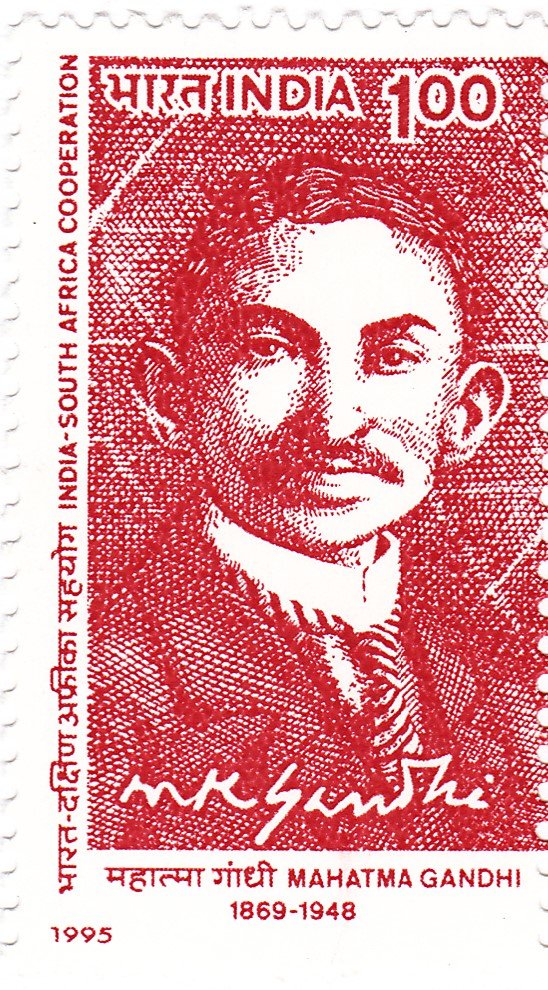India-South Africa Cooperation – Gandhi in South Africa

Technical Data
| Stamp Set | Mahatma Gandhi Memorial |
|---|---|
| Date of Issue | October 2, 1995 |
| Denomination | Rs. 1 |
| Quantity | 1,050,000 |
| Perforation | comb 13¼ x 13 |
| Printer | Security Printing Press, Nashik |
| Watermark | No Watermark |
| Colors | Scarlet |
| Catalog Codes |
Michel IN 1475 Stamp Number IN 1534 Yvert et Tellier IN 1253 Stanley Gibbons IN 1637 |
| Themes | Anniversaries and Jubilees | Famous people | Freedom Fighters | Joint Issues | Men |
Table of Contents
Commemorative Stamp: 125th Birth Anniversary of Mahatma Gandhi
Design Elements
- Mahatma Gandhi: The stamp features a portrait of Mahatma Gandhi, capturing his serene and determined expression, symbolizing his commitment to non-violence and social justice.
- Nelson Mandela: A secondary image of Nelson Mandela is included to emphasize the continuation of Gandhi’s legacy through Mandela’s leadership in the fight against apartheid.
- Pietermaritzburg Railway Station: The cancellation design showcases a line drawing of the Pietermaritzburg Railway Station, the site where Gandhi was thrown off a train due to racial discrimination, marking the beginning of his journey towards satyagraha.
Gandhi’s Legacy and the Fight Against Racial Discrimination
- Historical Context: Less than a century ago, racial segregation was a harsh reality, officially accepted and socially enforced in many parts of the world. In South Africa, this discrimination culminated in the legally enforced system of apartheid, which classified people by race and dictated every aspect of their lives.
- Gandhi’s Stand Against Injustice: Mohandas Karamchand Gandhi, then a young Indian lawyer, found himself among the oppressed in South Africa. He recognized the immorality of racial discrimination and took a stand against it. Gandhi’s response was unique—he organized non-violent mass movements, known as satyagrahas, against the oppressive racial laws.
- Non-Violent Resistance: Gandhi’s methods were based on the principles of non-violence, moral integrity, and love for the evildoer, aiming to win over even those who upheld unjust systems. His peaceful resistance to racism and injustice laid the groundwork for his later efforts in India, where he fought for social equality, economic self-reliance, and political freedom from British colonial rule.
- Impact on South Africa and Beyond: Gandhi’s approach had a profound influence not only in India but also in South Africa, where his ideas were later embraced by the African National Congress (ANC) in its struggle against apartheid. Nelson Mandela, a key leader of the ANC, drew inspiration from Gandhi’s philosophy, preferring reconciliation over recrimination and leading South Africa towards national reconstruction.
The Connection Between Gandhi and Mandela
- Shared Vision: Both Gandhi and Mandela shared a commitment to justice, non-violence, and the betterment of human society. Gandhi’s legacy in South Africa was carried forward by Mandela, who sought to heal the wounds of apartheid through peaceful means and foster a united nation.
- Mandela’s Tribute: In honoring Gandhi, Mandela described him as a moral force who invoked goodness and justice, a legacy that continues to inspire efforts towards building a fair and balanced human society.
Significance of the Commemorative Stamp
- Celebrating Gandhi’s 125th Birth Anniversary: The release of this commemorative stamp on October 2, 1995, marks the 125th anniversary of Mahatma Gandhi’s birth. The stamp serves as a tribute to Gandhi’s enduring influence on global movements for justice and equality.
- Symbol of Global Legacy: The stamp not only celebrates Gandhi’s life and work but also highlights the global impact of his ideas, particularly through the leadership of Nelson Mandela in South Africa. It symbolizes the shared struggle for human dignity and rights across continents.
- Pietermaritzburg Railway Station: The line drawing of Pietermaritzburg Railway Station on the cancellation is a poignant reminder of the incident that sparked Gandhi’s lifelong commitment to fighting injustice through peaceful means. This moment is recognized as the beginning of Gandhi’s journey towards satyagraha, which would later transform the world.
Example of the Stamp Design
- Stamp: The stamp features Mahatma Gandhi in the foreground, with Nelson Mandela’s image subtly placed in the background, representing the continuity of Gandhi’s legacy. The colors and design elements reflect the themes of peace, unity, and moral strength.
- First Day Cover: The cover includes the line drawing of Pietermaritzburg Railway Station, symbolizing the starting point of Gandhi’s fight against racial discrimination and his journey towards becoming a global icon of non-violent resistance.
Reaffirming Faith in Gandhi’s Legacy
The commemorative stamp released on Gandhi’s 125th birth anniversary serves as a powerful reminder of the values he championed—non-violence, justice, and the belief in the fundamental equality of all human beings. Through this stamp, the Department of Post honors not only Gandhi’s legacy but also the enduring influence of his ideas on leaders like Nelson Mandela and on the global struggle for human rights and dignity. This tribute reaffirms the belief that the world is a single family, bound by a shared commitment to peace and justice.
